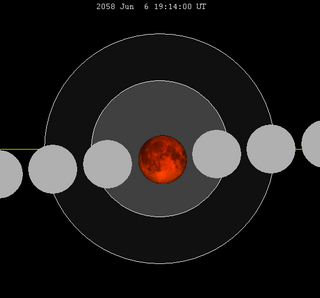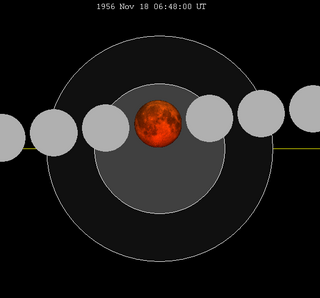
A total lunar eclipse took place at 0308 UT (GMT) on Thursday, August 17, 1989, the second of two total lunar eclipses in 1989.

A partial lunar eclipse took place on Monday, March 24, 1997, the first of two lunar eclipses in 1997.

A total lunar eclipse took place on 4 April 2015. It is the former of two total lunar eclipses in 2015, and the third in a tetrad. Other eclipses in the tetrad are those of 15 April 2014, 8 October 2014, and 28 September 2015.

A total lunar eclipse occurred on 15–16 May 2022, the first of two total lunar eclipses in 2022. The event occurred near lunar perigee; as a result, this event was referred to some in media coverage as a "super flower blood moon" and elsewhere as a "super blood moon", a supermoon that coincides with a total lunar eclipse. This was the longest total lunar eclipse visible from nearly all of North America since August 17, 1989 until the next eclipse on November 8.

A total lunar eclipse took place on Thursday, June 25, 1964. The Moon passed through the center of the Earth's shadow.

A total lunar eclipse will take place on 7-8 September 2025. The Moon will barely miss the center of the Earth's shadow. It will be the second of two total lunar eclipses. Occurring roughly 3 days before perigee, the Moon will appear larger than usual.

A partial lunar eclipse will take place on Friday 28 August 2026. The moon will be almost be inside the umbra, but not quite be contained within the umbral shadow at greatest eclipse.
A partial lunar eclipse took place on Tuesday, March 13, 1979, the first of two lunar eclipses in 1979. The Moon was strikingly shadowed in this deep partial eclipse which lasted 3 hours, 17 minutes and 40.6 seconds, with 85.377% of the Moon in darkness at maximum.

A total lunar eclipse took place on Monday, May 13, 1957, the third of fourteen total lunar eclipses of Lunar Saros 130. The Moon was plunged into darkness for 1 hour and 18 minutes, in a deep total eclipse which saw the Moon 30% of its diameter inside the Earth's umbral shadow. The visual effect of this depends on the state of the Earth's atmosphere, but the Moon may have been stained a deep red colour. The partial eclipse lasted for 3 hours and 32 minutes in total.
A partial lunar eclipse took place on Sunday, April 12, 1903. This nearly total lunar eclipse of Saros cycle 130 preceded the first total eclipse on April 22, 1921. The Moon was almost covered by the Earth's shadow in a very deep partial eclipse, which lasted 3 hours and 17 minutes, with 96.77% of the Moon in shadow at maximum eclipse.

A total lunar eclipse will take place on June 6, 2058. The Moon will pass through the center of the Earth's shadow.

A total lunar eclipse took place on Wednesday, October 18, 1967, the second of two total lunar eclipses in 1967, the first being on April 24, 1967.

A partial lunar eclipse took place on Thursday, March 2, 1961, the first of two partial lunar eclipses in 1961.

A total lunar eclipse took place on Sunday, November 18, 1956.

A total lunar eclipse will take place on May 17, 2087. The moon will pass through the center of the Earth's shadow.

A total lunar eclipse will take place on September 19, 2043.

A total lunar eclipse will take place on March 25, 2043.

A total lunar eclipse will take place on April 26, 2051.

A total lunar eclipse will take place on May 6, 2069. The eclipse will be a dark one with the southern tip of the Moon passing through the center of the Earth's shadow. This is the first central eclipse of Saros series 132.

A total lunar eclipse will occur on Wednesday, June 9, 2123, with maximum eclipse at 05:06 UTC. A dramatic total eclipse lasting 106 minutes and 6 seconds will plunge the full Moon into deep darkness, as it passes right through the centre of the Earth's umbral shadow. While the visual effect of a total eclipse is variable, the Moon may be stained a deep orange or red colour at maximum eclipse. This will be a great spectacle for everyone who sees it. The partial eclipse will last for 3 hours and 56 minutes in total. The penumbral eclipse lasts for 6 hours and 14 minutes. Maximum eclipse is at 05:06:28 UT. This will be the longest Total Lunar Eclipse since 16 July 2000, and the longest one until 12 May 2264 and 27 July 3107, though the eclipse on June 19, 2141 will be nearly identical in all aspects. This will also be the longest of the 22nd century and the second longest of the 3rd millennium. The eclipse on June 19, 2141 will be the second longest of the 22nd century and the third longest of the third millennium.







































































































